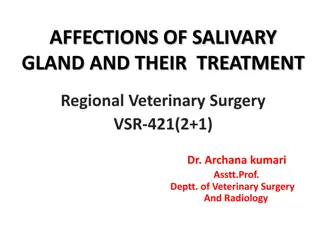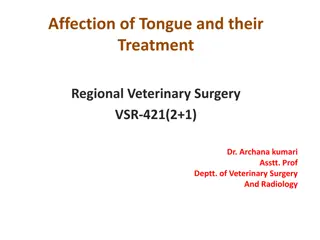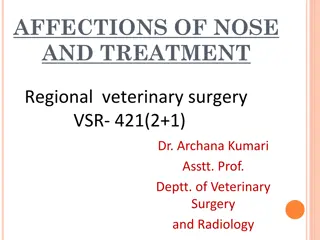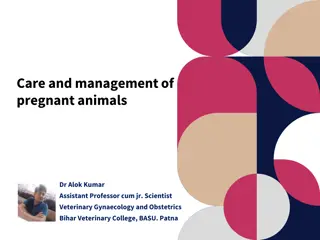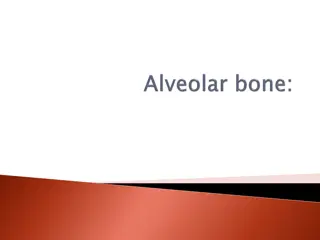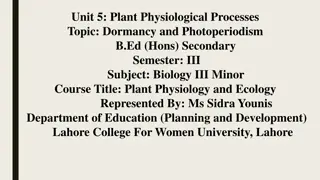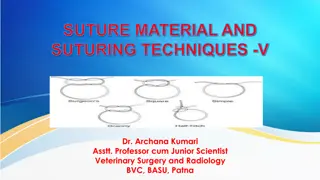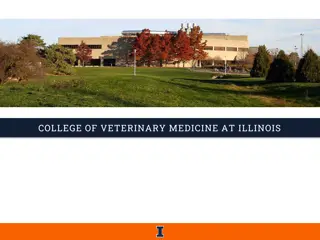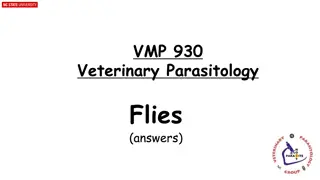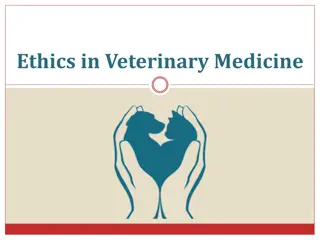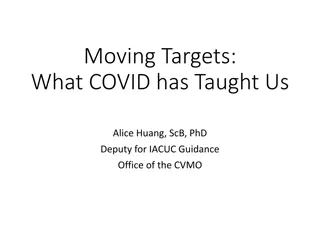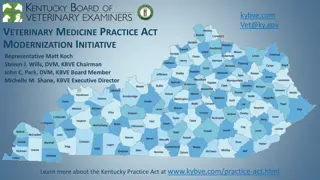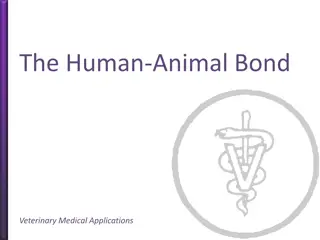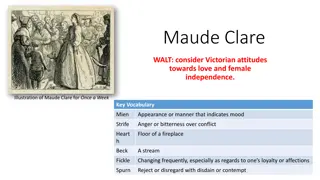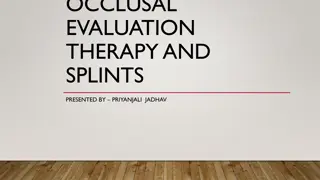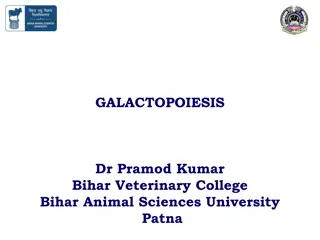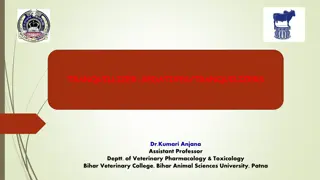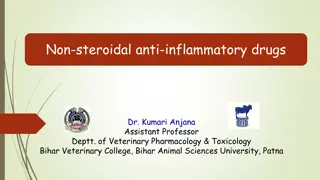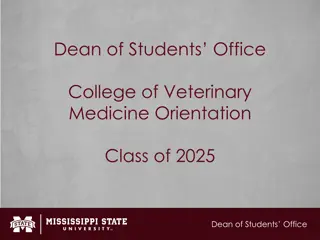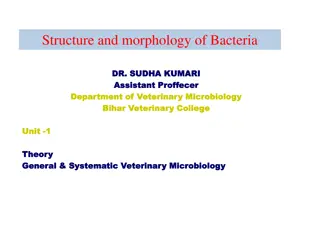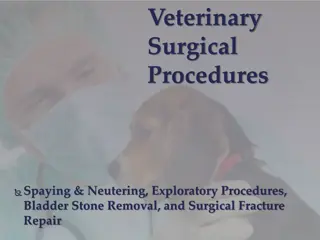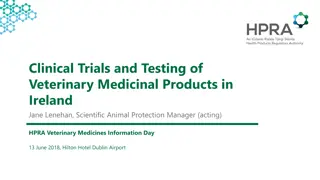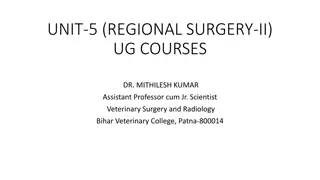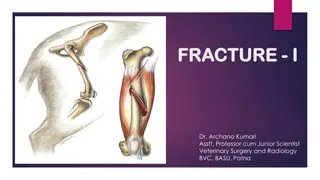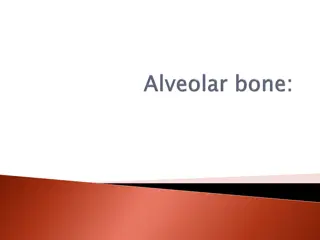Veterinary Management of Jaw Affections and Treatments
Affections of the jaw in animals can range from congenital conditions to inflammatory diseases like gnathitis and lymphadenitis. Paralysis of the lower jaw, gnathitis from bit injuries, and lymphadenitis are discussed, along with their etiology, clinical signs, and treatment options such as general paralysis treatment, bit discontinuation, and gland inflammation management.
Download Presentation

Please find below an Image/Link to download the presentation.
The content on the website is provided AS IS for your information and personal use only. It may not be sold, licensed, or shared on other websites without obtaining consent from the author. Download presentation by click this link. If you encounter any issues during the download, it is possible that the publisher has removed the file from their server.
E N D
Presentation Transcript
Affections of Jaw and their Treatment Regional Veterinary Surgery VSR-421(2+1) Dr. Archana kumari Asstt.Prof. Deptt. of Veterinary Surgery And Radiology
Congenital Affections of Lower Jaw and Treatment Paralysis of lower jaw Paralysis of lower jaw is fairly common complication in dog, rare in the horse and ox and may be of unilateral or bilateral, partial or complete and central or peripheral in origin. Etiology . Affection of peripheral nerve due to pressure by tumours, extravasated blood or direct injury or toxin of infectious disease like distemper in dog.
Signs In unilateral paralysis (a)Prehension and movements of the tongue are normal but mastication is interfered. (b)The animal holds the head low and towards the sound site so that food material is passed towards the corresponding molars. In unilateral paralysis (a)Slow intermittent masticatory movements in incomplete paralysis. (b)In complete paralysis, loss of masticatory movements on both sides, drooping of lower jaw, dry tongue protruded from the mouth. (c)The dog is able to swallow liquid diet and solid food when placed in its mouth. Treatment: Treatment of this condition is same like that of general treatment of paralysis.
Gnathitis Gnathitis is an inflamatory condition of the interdental space in horse due to injury caused by bits. The inflammation in mucous membrane is mild in nature and may affect the underlying tissues like periosteum and bone. The animal feels severe pain when the bit is moved. There is pus formation and may also affect the underlying bone.
Treatment of this condition includes: To discontinue to use of bit for certain periods till normal healing is achieved. Drainage of pus material if suppuration develops. Removal of necrosed (sequestrum) is indicated if bone is involved. piece of bone
Lymphadenitis of jaw Lymphadenitis refers to inflammation of lymphatic gland. The condition is mostly encountered in goats, sheep and horses. The main etiology of this condition is infection i.e. Streptococcus, Staphylococcus and Corynebacterium pseudotubdrculosis. In horses, disease like strangles may lead to this condition. The clinical signs include enlargement of lymph gland, presence of external abscess beneath the jaw (more common in goat), internal abscess (more common in sheep) and chronic weight loss.
Treatment of this condition includes: In simple inflammation of gland, blistering ointments are helpful as counterirritant. Administration of potassium iodide and antibiotics (based on causal organism). If there is abscess formation in jaw area, use a disposable scalpel to cut the surface of the abscess and drain it before it ruptures on its own in the field. The abscess is about to rupture when it has lost hair. In chronic lymphadenitis, extirpation of the affected gland is recommended.
Injuries and fracture of hyoid bone Injuries and fracture of hyoid bone are infrequently observed in animals. Etiology In dog, this may occur due to rough capture by the throat during securing stray animals. In horses and cattle, kicking, violent traction on the tongue and horn thrusts may be main reason.
Signs Salivation. Difficulty (dysphagia).Prolapse of tongue. Accumulation of food in the mouth and swelling in the throat. Bleeding from mouth due to tearing of hypoglossal artery or other vessels. in eating and especially in swallowing Treatment Semi liquid diet may be offered in simple fracture. Through cleaning of wound in the mucous membrane after each meal. Fragments of bone should be removed if there any. .
Crib biting Crib biting is where horses use their teeth to grasp onto objects, such as their manger, or the top of their stable door, then arch their necks and swallow air called wing sucking. This behavior has always been regarded as a 'vice' of the horse, and has been linked to various forms of ill- health including worn teeth colic, stomach ulcers, hypertrophy of the muscles of the ventral neck, and a failure to maintain body weight. Although a nutritional deficiency may be an underlying cause, if the horse is being fed a balanced diet and has free access to a mineralized salt block, this should not be the case.
Control of this condition is directed to horse owners need to reappraise their management practices and use alternative and humane methods to prevent the development of crib-biting. The problem can be controlled by: Minimizing the number of surfaces which the horse has available to chew: for example, removing the manger, placing a strip of metal over the top of the door or placing a grille on the door. The surfaces should not make unpleasant to taste as this is only likely to make the horse more frustrated. It is better to allow horse to crib bite on a suitable surface, such as a hard rubber board, than to try to physically prevent the behavior with straps or collars. Some horses are helped if they have a companion- a small pony, a sheep or a goat. Others are improved if a solid object, such as a rubber ball, is hung from the ceiling.
AFFECTIONS OF PALATE AND TREATMENT
LAMPAS Lampas is an inflammatory thickening of the mucous membrane of the hard palate appearing as ridge immediately behind the upper incisors. This conditions commonly observed in horses when the incisors are erupting. Pain is evidenced when biting hard feedstuffs. Treatment of this condition is directed to scarify the mucous membrane. Soft foods should be offered to minimize pain during chewing.
CLEFTPALATE congenital disorder occurs in all species commonly observed in brachycephalic breeds of canine. chronic nasal discharge and pneumonia lead its diagnosis as a neonate or young foal Etiology Nutritional, hormonal and mechanical factors Genetic and stress factors are also responsible for this condition. Intrauterine infection and exposure to toxins at specific periods of gestation may also lead to this situation.
Signs Food material passes to the nostrils on expiration and to the pharynx on inspiration. In early stages of life, rhinitis or pneumonia occurs. Milk or food in the nasal cavity frequently causes sneezing or gaggling. In some cases, the animal is unable to create a negative pressure in the mouth and may lead to death by starvation. Treatment: Surgical reconstruction of cleft palate condition is indicated by pedicle flaps of palatine mucosa.
PALATINETUMOURS Palatine tumours like malignant melanoma, squamous cell carcinoma and fibrosarcoma are common in dog and cat Malignant melanomas arise from the gingival and palatine epithelium (hard palate) and infiltrate the underlying bone. The tumour is usually ulcerated and may bulge into the oral cavity. Incidence of fibrosarcoma of palate is higher in larger breed dogs and in male as compared to female. Squamous cell carcinoma is locally invasive and cause lysis of bone.
Clinical signs Slow progressive facial swelling. Abnormal salivation. Oral haemorrhage. Difficulty in eating. Treatment. Early detection, diagnosis and treatment Surgery is the most effective mode of therapy for treating most oral neoplasms. Sharp dissection rather than electrocautery should be utilized when incising palatal mucosa to minimize postoperative dehiscence. Fibrosarcoma is a better candidate to radical surgical excision because of its lower metastatic rates. Local recurrence is very common if excision is not performed in a radical manner. Cryosurgery is a good therapeutic option because the ice ball reach areas of alveolar bone and destroy malignant cells
PROTRUSIONANDSTRANGULATIONOF SOFTPALATEINCAMEL / DULLA occurs in male camel while creating oral sounds. injury of soft palate due to sharp molars or canine teeth Due to injury, the walls of soft palatem perforate, causing rupture of blood vessels and ultimately leading to submucoasal haematoma. Soft palate becomes infected due to entry of microbes. If the soft palate still protruded outside, blood supply is seriously compromised leading to necrosis and gangrene. Treatment Surgical excision of the affected part of the soft palate. Under sedation with xylazine hydrochloride and restraining in sterna recumbency, The soft palate is taken out by pulling the tongue and dissected laterally from both sides beginning from the rostral dorsal attachment. Postoperatively, the oral cavity is flushed with warm normal saline solution followed by light antiseptic solution like potassium permanganate. A course of antibiotic for 5 to 7 days is indicated. The animal should be offered succulent type of feed at least for 2 weeks.


